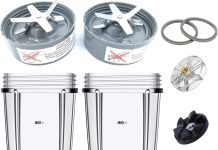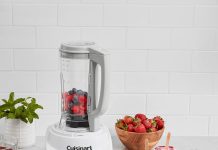In this article, we will explore some effective methods for reducing foam in freshly juiced drinks. Foamy drinks can be frustrating to consume, as they can affect the taste and overall experience. Whether you’re a juice enthusiast or a professional bartender, finding ways to minimize foam and achieve a smooth, enjoyable drink is essential. We will discuss key techniques and ingredients that can help you achieve just that, ensuring that every sip is a delightful one.
Review contents
Understanding the Foam in Freshly Juiced Drinks
Causes of Foam Formation
When it comes to enjoying a glass of freshly juiced drink, a foamy layer on top may be a cause for frustration. Understanding the reasons behind foam formation can help us tackle this issue more effectively. Foam is primarily caused by the presence of air bubbles that get trapped in the juice during the juicing process. These air bubbles are typically formed when the juicer rapidly spins or otherwise agitates the ingredients. Additionally, the natural sugars and proteins in fruits and vegetables can contribute to the foam formation.
Impact of Foam on Flavor and Aesthetics
Foam not only affects the aesthetic appeal of freshly juiced drinks, but it can also influence the flavor experience. Many people find the frothy layer on top to be undesirable due to its texture and taste. The foam tends to contain a higher concentration of bitter compounds, which can alter the overall flavor profile of the drink. This can be particularly disappointing when enjoying delicate flavors that are meant to be enjoyed in their purest form.
The Importance of Reducing Foam in Freshly Juiced Drinks
Reducing foam in freshly juiced drinks is crucial for both the presentation and taste of the beverage. By minimizing foam, we can enhance the visual appeal, making the juice more visually enticing. Additionally, reducing foam helps to preserve the natural flavor and integrity of the ingredients without any unwanted bitter or unpleasant aftertastes. By adopting techniques to reduce foam, we can elevate our juicing experience and truly savor the flavors of the fruits and vegetables.
Tips and Techniques to Reduce Foam in Freshly Juiced Drinks
Use the Right Type of Equipment
Selecting the appropriate juicing equipment plays a significant role in minimizing foam formation. Centrifugal juicers, which use high-speed spinning blades, tend to introduce more air into the juice, resulting in increased foam. On the other hand, masticating or cold-pressed juicers manually squash and press the produce, resulting in a lower foam yield. Choosing a juicer that operates at lower speeds can effectively reduce the introduction of air bubbles, leading to less foamy juice.
Prep Your Ingredients Properly
Properly preparing the ingredients before juicing can also help minimize foam. Washing fruits and vegetables thoroughly removes any residual dirt or pesticides that could contribute to foam formation. Additionally, peeling certain fruits or vegetables that have a higher tendency to create foam, such as citrus fruits or cucumbers, can help reduce froth. By removing the outer layer, we eliminate some of the compounds that contribute to bubble formation.
Control the Juicing Process
Controlling the juicing process is essential in reducing foam. One technique is to feed produce slowly into the juicer to prevent excessive air incorporation. By gently pressing or pushing the ingredients at a steady pace, we can minimize agitation and reduce the amount of foam generated. It is important to avoid overloading the juicer, as this can increase the air trapped within the juice, resulting in more foam.
Consider Temperature and Timing
The temperature at which produce is juiced can impact foam formation. Juicing ingredients at colder temperatures can minimize foam due to reduced agitation. Pre-chilling fruits and vegetables in the refrigerator prior to juicing can help achieve this. Additionally, timing is key to reducing foam. Juicing immediately after prepping the ingredients prevents oxidation, which can contribute to foam. Ensuring minimal delay between prepping and juicing helps maintain the integrity of the ingredients and reduces the likelihood of excessive foam.
Choose the Right Ingredients
The choice of ingredients can significantly affect foam formation. Some fruits and vegetables naturally produce more foam than others. Citrus fruits, melons, and leafy greens, for example, have a tendency to produce frothy juice. By avoiding excessively foamy ingredients or balancing them with other non-foaming produce, we can achieve a more desirable consistency. Additionally, choosing ripe and high-quality produce reduces the enzyme activity and minimizes foam generation during juicing.
Utilize Clarifying Agents
Adding clarifying agents to freshly juiced drinks can help reduce foam and improve clarity. Popular options include items such as lemon juice or apple cider vinegar, which contain enzymes that break down proteins and minimize foam formation. Adding a small amount of these clarifying agents to the juicer or incorporating them into the juice after juicing can help enhance the appearance of the final product by reducing foam and improving its overall transparency.
Explore Different Juicing Methods
Experimenting with different juicing methods can also yield less foamy results. For instance, using a blender or food processor instead of a juicer can produce a thicker, less frothy juice. This method retains more fiber, resulting in a smoother consistency. Additionally, incorporating juicing techniques such as straining the juice through a fine-mesh sieve or cheesecloth can help remove remaining foam, leaving behind a clearer and more enjoyable drink.
Experiment with Different Ratios
Finding the right ingredient ratios can contribute to a reduced foam outcome. Adjusting the proportions of foaming and non-foaming ingredients can help strike a balance and control the amount of froth in the finished juice. Experimenting with different combinations and ratios can be an enjoyable way to create personalized recipes and achieve the desired consistency and taste.
Try Cold-Pressed Juicing
Cold-pressed juicing is gaining popularity due to its ability to minimize foam and preserve the natural flavors of the ingredients. This method involves using a specialized juicer that slowly presses the produce, resulting in minimal air incorporation and foam production. While cold-pressed juicers may be more expensive, they offer a superior juicing experience with significantly reduced foam and improved taste.
Practical Tips for Foam Removal
If foam remains after applying the aforementioned techniques, a few practical tips can help reduce foam right before consumption. Using a spoon or a small strainer, skim off the foam from the top of the glass. This simple act can make a noticeable difference in the texture of the drink. Additionally, giving the juice a gentle stir or swirl before drinking can help distribute the foam more evenly throughout the beverage, making it less noticeable.
In conclusion, foam in freshly juiced drinks can impact both the aesthetics and flavor profile of the beverage. By understanding the causes of foam formation and implementing the tips and techniques discussed, we can reduce foam and enjoy a visually appealing and delicious glass of freshly juiced drink. From selecting the right juicing equipment to experimenting with different ingredients and methods, there are various ways to minimize foam and enhance the overall juicing experience. So, let’s raise our glasses to foam-free, flavorful, and refreshing drinks!

































